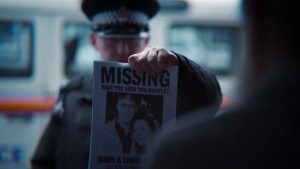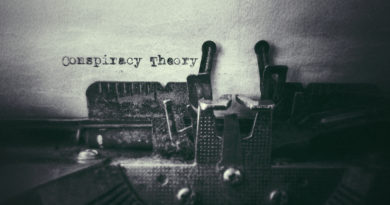American Conspiracy: The Octopus Murders JFK Scene Explained
As visualized in Netflix’s provocative new four-episode series from the producers of “Wild Wild Country,” the Octopus is a vast, eight-limbed constellation of powerful names bent on geo-political domination. The connections between shadowy rogues and once-high-ranking figures like George H.W. Bush map out the “political conspiracy of the century” that could “re-write American history,” according to writer Danny Casolaro.
In 1991, Casolaro was found dead in a blood-splattered hotel room. The official story said it was a suicide (many believe he was murdered) and his unfinished investigation has remained a wellspring of great intrigue for more than three decades.
Articles, books, an episode of “Unsolved Mysteries” and even a dramatic play have explored Casolaro’s research into the convoluted latticework of software developers, the NSA, the DOJ, the CIA, arms dealers, casino bosses, thugs, thieves, hitmen, conmen, creeps, kingpins and regular average citizens. The John Kennedy assassination, granddaddy of all conspiracies, is not one of the tentacles of the Octopus, but read on to find out the macabre way it’s fused into the fabric of Casolaro’s story.
[embedded content]
Ten years ago, a New York photojournalist named Christian Hansen became intoxicated with the case, submitting freedom-of-information requests and piling his apartment with boxes of research and documentation. His longtime friend, filmmaker Zachary Treitz, chronicles Hansen’s obsessive quest for the truth of Casolaro’s death in “American Conspiracy: The Octopus Murders” (available on Netflix).
“I didn’t read a lot of conspiracy literature before this,” Treitz tells TheWrap. “I didn’t have strong opinions on the JFK assassination or aliens or Roswell. So the lodestar for what were were doing was just asking simple questions: What happened to Danny? What was he writing about? How can all these people know each other? How do all these things fit together?”
Though not difficult to follow, “The Octopus Murders” is so packed with data, some from apparently unreliable narrators, that the series turns meta and eventually folds into itself. Especially in its compelling third and fourth episodes, the show becomes a deft examination of how following a mystery can be its own perpetual motion machine, challenging us to question the ways that true crime obsession warps the mind.

That idea comes to its sharpest point in the series’ most spellbinding sequence. Halfway through the third episode, titled “The Game,” we’re introduced to Cheri Seymour, a California-based writer and investigative reporter whose 2010 book “The Last Circle” is about Casolaro’s reporting and death.
Chillingly, Seymour describes a meeting she claims to have had in 1992 with a man named Robert Booth Nichols at his home – a safe house, Seymour says she suspected. Nichols was a “government facilitator” and had met Casolaro as a background source for the book Casolaro was writing. Seymour claims Nichols told her that “no journalist has done enough work to deserve to know” the reason why Casolaro was murdered.
Then, Seymour says, Nichols showed her video of what he claimed was the real Zapruder film, the infamous recording of the 1963 assassination of President John F. Kennedy in Dallas.
But in this version, the kill shot does not come from across the street. As Seymour vividly describes in the series, the purported video showed the driver of Kennedy’s car turns around with a gun in his hand and shoots the president at close range in the head.
“I’m thinking, ‘This isn’t the tape I ever saw before,” Seymour says in the episode. She claims Nichols then played the real Zapruder film, where he pointed out a tree in the background that had the bottom of its trunk missing – a tech glitch, he falsely told her, that proved the “media version” was doctored.
Nichols then snarled to Seymour, “Nothing is at it appears to be.”

Seymour asserts that the whole event was a ruse “to provide deniability for Robert Booth Nichols,” she says, so that “my ability to see the truth or report the facts kind of goes out the window when you start describing that film, especially if you say you believed it.” Which, to be clear, she did not.
Director Treitz and his team “tried desperately,” he says, to locate the fake Zapruder film that Seymour claims to have watched in Nichols home. In a bold flourish, the filmmakers do provide an improbable glimpse at half of a tree trunk in the original footage. We then see the whole tree as it exists in the film, but the titillating embellishment helps amplify the themes of maneuvering and misdirection in the series.
“We’re telling a story that largely took place 30 or 40 years ago, with people who are dead or, in the case of Robert Booth Nichols, supposedly dead,” Treitz said to TheWrap. Nichols died, according to a source, in 2009 in Switzerland.
“In this scene with the Zapruder film, it’s a very subjective story that Cheri Seymour is telling. Cheri is a reliable narrator and has a very good memory, but she’s telling an abstract story that feels haunted and creepy. So we chose a play-like, ‘Dogville’-like way of depicting it, which speaks to the subjectivity of the situation.”
Treitz continued, “I don’t believe for a second that the driver turned around and killed JFK. There’s an element of mind control here, for lack of a better word, or at least manipulation of reality, which the characters in our story seem to be familiar with. This JFK tape story shows a situation where you can’t help but believe your eyes – there’s that disparity between what you know is true and what you’re seeing. And it does some weird manipulation inside of you, where you suddenly don’t know what’s real.”
Treitz explained how the anecdote is crucial in understanding the wide-angle thesis of “The Octopus Murders.”
“I think it bears mentioning that when they did a report on the death of Danny Casolaro, the story the FBI and DOJ went with was that he was manipulated by con artists into believing a fake story,” he said. “And I don’t even completely disagree that con artists were trying to manipulate Danny. But where I disagree is in thinking that we know whether Danny believed all those things. And I don’t think it makes these people any less dangerous.”
Paradoxically, sources like Nichols are more threatening if they are dismissed as fringe, Treitz said. “Robert Booth Nichols was good at this whole myth and mystery thing. And like Cheri Seymour said, ‘You tell that JFK story to someone else and they’ll think you’re crazy.’ So what’s that do for Robert Booth Nichols? It opens up a lot of places where suddenly he’s just a kook and a weirdo and you can’t trust anything he says.”
And Robert Booth Nichols is just one part of the large ensemble in “The Octopus Murders.” In addition, we encounter a Casolaro confidante named Michael Riconosciuto, who Treitz and Hansen pick up in a prison parking lot in 2017. FBI informant and probable serial killer Philip Arthur Thompson also links to the story. And a likable, charming man in the California desert named Bobby Moses Nichols is interviewed about his consequential father, Dr. John Philip Nichols.
“There are too many people named Nichols,” said Treitz with a laugh, referring to the complex cast of characters in the series. “This could have been, ultimately, a 30-part series and a mildly entertaining one. This story is like a big cave system and we know that there are tunnels we didn’t get to explore. We’re haunted by that.”
But he added, “I think that we did a good job of putting things into a balanced, tangible reality as best we could – while still explaining that the intangibles and the subjective part of it are an important feature, not a bug.”



